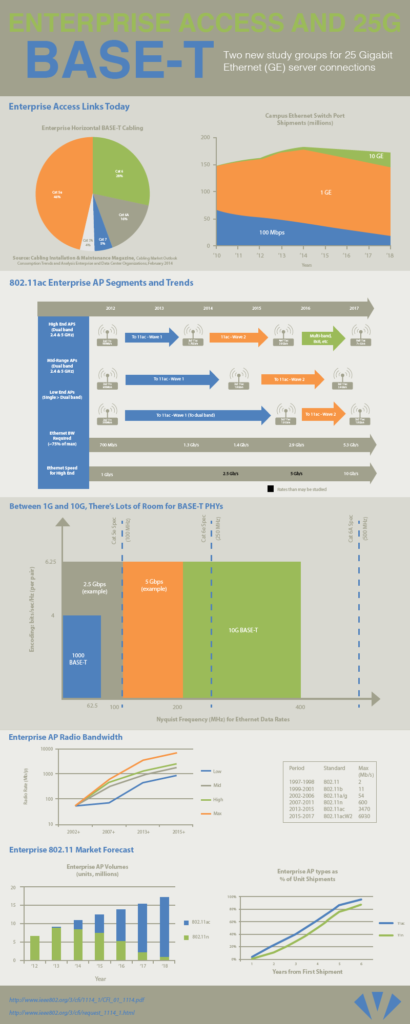IEEE recently held a plenary this month in San Antonia, Texas that resulted in the addition of two more study groups–Enterprise Access BASE-T and 25GBASE-T for 25GE server connections. Out of 131 members who attended the plenary, 97 voted to move forward with the project and only 1 voted against it while 23 abstained to vote.
The Ethernet Alliance’s press release discloses that the 25GBASE-T standard logically follows efforts to standardize 25GbE Ethernet for data centers. The 25GbE Ethernet study group developed its own consortium in the interim that IEEE perceived little interest in the project briefly stalled the study group.
 John D’Ambrosia, Chairman of the Ethernet Alliance, comments that Enterprise Access BASE-T “is a more recent example of Ethernet breaking from its “one size fits all” mentality and moving to a more pragmatic approach. It also nicely illustrates how a solution will be driven by the economics of the application it is targeting.” He refers to the fast adoption of the 802.11ac standard ratified on December 2013.
John D’Ambrosia, Chairman of the Ethernet Alliance, comments that Enterprise Access BASE-T “is a more recent example of Ethernet breaking from its “one size fits all” mentality and moving to a more pragmatic approach. It also nicely illustrates how a solution will be driven by the economics of the application it is targeting.” He refers to the fast adoption of the 802.11ac standard ratified on December 2013.
IEEE forecasts that in 5 years, 95% of 802.11 devices will support the 802.11ac standard and which are quickly replacing 802.11n devices.
Manufacturers even released 802.11ac based on the pre-standard. The market expects a second wave of 802.11ac to release in early 2015 and the new devices “will offer significant performance improvements for campus deployments.”
Enterprise campus access connections comprise of enterprise access links that connect with 1000BASE-T over Cat5 and higher UTP cable. However, as John D. Ambrosia explains, “The problem with this plan…is that 10GBASE-T is not specified to operate over CAT5e cabling, and the reach on CAT6 cabling is dependent on the cabling itself, as well as how it was deployed”.
Enterprise Access BASE-T will cover speeds between 1Gb and 10Gb over CAT5 and higher UTP cabling, and support backwards compatibility. The standard also needs to delineate Energy Efficient Ethernet specifications. John D. Ambrosia further relates that these new specifications will reinforce the necessity for four-pair PoE standards currently created by the IEEE 802.3bt Task Force which supports more than 25 watts of power.
Do you see a future for four-pair standards for home applications? Let us know what you think. Leave us a comment below.



